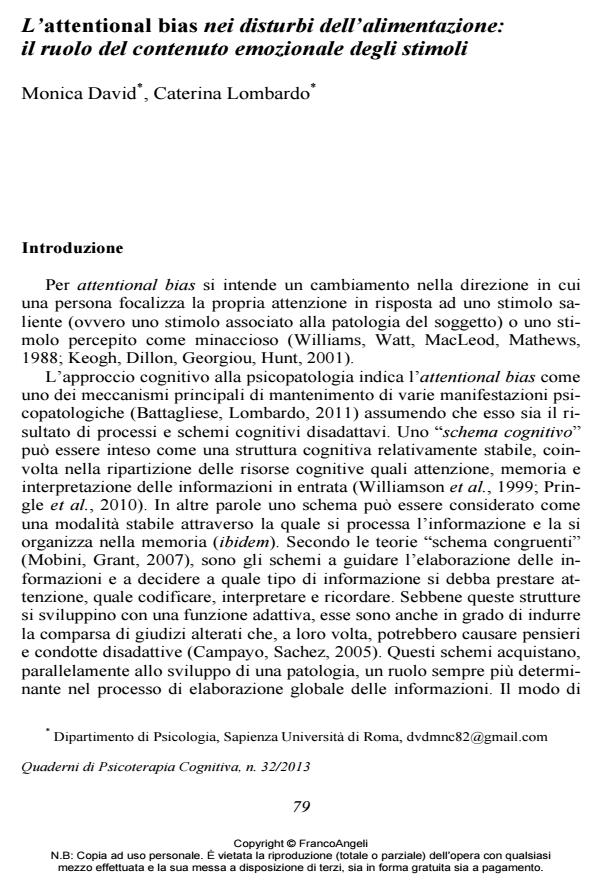L’attentional bias nei disturbi dell’alimentazione: il ruolo del contenuto emozionale degli stimoli
Titolo Rivista QUADERNI DI PSICOTERAPIA COGNITIVA
Autori/Curatori Monica David, Caterina Lombardo
Anno di pubblicazione 2013 Fascicolo 2013/32
Lingua Italiano Numero pagine 18 P. 79-96 Dimensione file 453 KB
DOI 10.3280/QPC2013-032006
Il DOI è il codice a barre della proprietà intellettuale: per saperne di più
clicca qui
Qui sotto puoi vedere in anteprima la prima pagina di questo articolo.
Se questo articolo ti interessa, lo puoi acquistare (e scaricare in formato pdf) seguendo le facili indicazioni per acquistare il download credit. Acquista Download Credits per scaricare questo Articolo in formato PDF

FrancoAngeli è membro della Publishers International Linking Association, Inc (PILA)associazione indipendente e non profit per facilitare (attraverso i servizi tecnologici implementati da CrossRef.org) l’accesso degli studiosi ai contenuti digitali nelle pubblicazioni professionali e scientifiche
La letteratura scientifica ha sottolineato ormai da tempo il ruolo di bias attentivi nell’etiologia e nel mantenimento della psicopatologia. Il bias attenzionale può essere definito come il cambiamento nella direzione in cui una persona focalizza la propria attenzione in risposta ad uno stimolo associato alla propria patologia oppure in risposta ad uno stimolo percepito come minaccioso. La presente rassegna esamina i risultati ottenuti dagli studi condotti nell’ambito dei disturbi dell’alimentazione allo scopo di valutare se le caratteristiche metodologiche, quali il tipo di paradigma o la tipologia di stimoli usati per indurre il fenomeno dell’attentional bias, producono risultati differenti. Per lo più si tratta di studi condotti con il paradigma Stroop che, sebbene criticato, ha permesso di evidenziare il diverso comportamento dei pazienti con anoressia e bulimia; mentre i primi sembrerebbero maggiormente focalizzati sul corpo, i secondi anche sugli stimoli legati al cibo. Molto probabilmente ciò è dovuto ai diversi meccanismi che vengono messi in atto: evitamento cognitivo (nel caso dei pazienti con anoressia davanti a stimoli legati al cibo) e craving (nel caso dei pazienti con bulimia davanti agli stessi stimoli). Inoltre, usando paradigmi diversi (odd-one-out e dot-probe) è stato possibile distinguere anche nel campo dei disturbi dell’alimentazione due diverse componenti del costrutto: speeded detection (lo spostamento dell’attenzione verso) e increased distraction (la difficoltà a distogliere l’attenzione da). Tuttavia, sebbene questi paradigmi siano frequentemente utilizzati nel campo dei disturbi d’ansia, nel caso dei disturbi dell’alimentazione gli studi sono ancora poco numerosi per poter trarre delle conclusioni definitive.
Parole chiave:Attentional bias, disturbi dell’alimentazione, anoressia nervosa, bulimia nervosa, body exposure, food exposure
Monica David, Caterina Lombardo, L’attentional bias nei disturbi dell’alimentazione: il ruolo del contenuto emozionale degli stimoli in "QUADERNI DI PSICOTERAPIA COGNITIVA" 32/2013, pp 79-96, DOI: 10.3280/QPC2013-032006